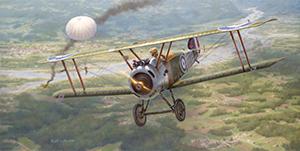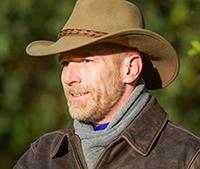
Russell Smith
Biography and Works
Russell's love of drawing was evident at a young age. After majoring in art at Augusta State University, he spent nine years working in the prepress industry while creating and selling his artwork on the side and most recently he has realized his dream of becoming a full time artist. Over the past few years Russell has self published several open and limited edition prints.
His work can be seen in many collections around the country and has been recognized by several international publications including Aviation History, Flight Journal, Flying, and Aviation Art. In addition, Russell's work has been included in many national and international exhibitions including the Icarus Art of Flight Exhibition, the Simuflite/Flying Magazine Horizons of Flight Art Exhibition. Russell has been the recipient of several awards and honors including an Honorable Mention in the Experimental Aircraft Association 1999 Art Exhibition.
Gallery
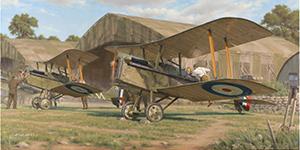
The actual tones used on D3511 are speculative at best. Those used here are based on the work of WWI aircraft profile artist Ronny Bar.
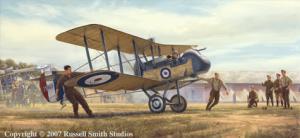
The machine seen here was assigned to 32Sq based at Vert Galand, one of the best known British aerodromes on the Western front. This field saw continuous use from 1915 until 1919, and many of the WW1 era buildings can still be seen there today.
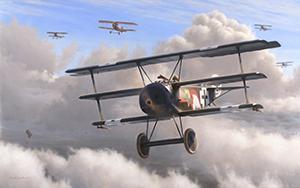
Although it is uncertain how frequently Jacobs flew 450/17,in his wartime diary he definitively attached that aircraft to one event - a balloon claim for May 14,1918. His combat report for that day reads as follows:
Fok. Dr I 450/17: black triplane with a devil's head on both sides of the fuselage behind the pilot's seat. At 0410 hours I started with my Staffel for a patrol to the front - because there was little aerial activity, and I noticed some English balloons through the clouds, I decided for a balloon attack. With my whole Staffel I raced down through the clouds, immediately opening fire at the first which ignited at once, burning fiercely.
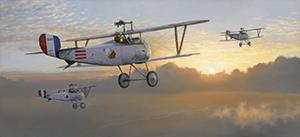
The Lafayette Escadrille was formed in April of 1916, prior to the US entry into WW1. It had the unique distinction a French Sqaudron made up almost entirely of American Volunteers. The escadrille flew several different types of single seat fighters during its span and was officially known as N124 (during the period that they flew Nieuports) or SPA124 (during the period that they were assigned SPADs).
The machine that is perhaps most associated with the Escadrille was the Nieuport 17. The 17, an improvment on the earlier Nieuport 11 and 16 designs, carried a Vickers machine gun mounted to fire through the propeller arc and often carried a Lewis gun mounted on the top wing. The fabric surfaces of N17 were usually covered in an aluminum-based dope, giving the machine a silver appearance.
In the foreground we see Raoul Lufbery, the highest scoring and most well-known pilot of the Lafayette Escadrille. Lufbery is at the controls of Nieuport 17 N1844, a machine assigned to the group's Captain, Georges Thennault, but usually associated with Lufbery. A quiet man of mixed French and American decent, Lufbery took great care of his equipment. His plane was always the best in the squadron, as noted by fellow pilot Edward Hinkle, “Anyone would rather have a secondhand Lufbery machine than a new one anytime”.
In the lead, flying N1803 is Lt William Thaw. Thaw was one of the original founders of the Lafayette Escadrille and is credited with the idea of using the famous Seminole Indian head as the group's logo (see Mark of Distinction).
Finally, below and beyond Lufbery is Dudley Hill, flying N1950. Hill, the 12th man to voluteer for the escadrille was blind in one eye but never the less passed his physical exams by memorizing the eye chart. He was a well-liked pilot and managed to log more flying time than any other escadrille member.
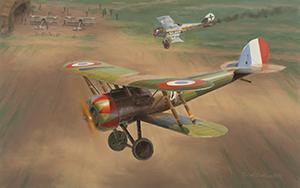
The Pfalz crashed about 100 yards directly behind the 94th’s hangars.
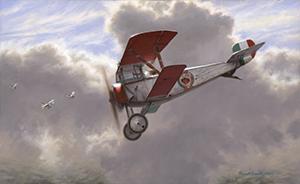
The fuselage of Allasia’s Nieuport 11 was marked carried the image of Fortunello, a cartoon character poplar during that period. Each aircraft on his unit, 80 Squadriglia, carried a variation of the figure.
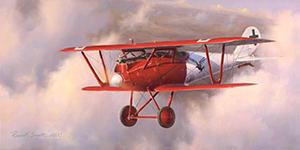
After the transition, Jasta 18 was commanded by Ltn August Raben and the unit became unofficially known by its commander's name - Jasta Raben (German for "ravens"). The unit's new colors featured a distinctive red and white color scheme with a black Raven emblazoned on the fuselage.
Though the unit was mostly made up of Albatrosses, and later, DVII's, this particular Pfalz DIIIa was also assigned to the unit. Ltn d R Hans Müller, a 12 victory ace, is known to have flown this aircraft during the spring of 1918. Müller's personal insignia included diagonal fuselage bands and a chevron striped tailplane, however no photographic evidence is known to exist to suggest that this aircraft carried those markings.
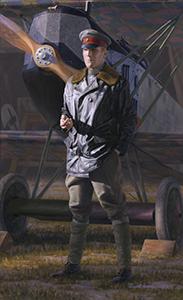
This was not simply just a case of me painting directly from a photo. To give an even better sense of time and place, I pulled out a good shot that I had of a DVII taken from waist level. I did some quick number crunching and figured out approximately how far from the airplane I was when I took the photo, how far in front of the aircraft the figure needed to be (in theory) to fit proportionally and finally, how far I needed to be from the camera to get the proper reference shot.
